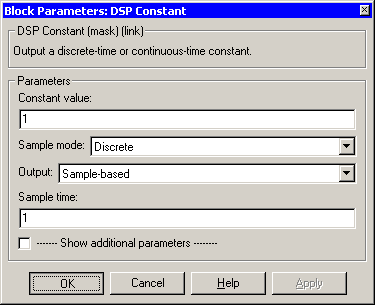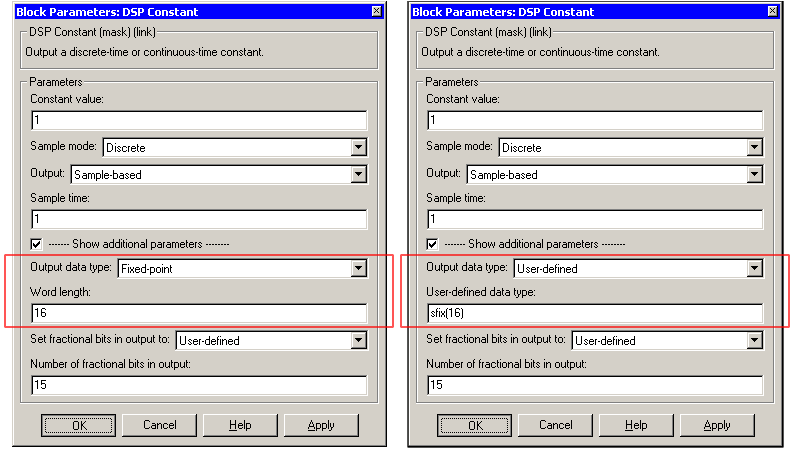| DSP Blockset |
  |
DSP Constant
Generate a discrete-time or continuous-time constant signal.
Library
DSP Sources
Description

The DSP Constant block generates a signal whose value remains constant throughout the simulation. The Constant value parameter specifies the constant to output, and can be any valid MATLAB expression that evaluates to a scalar, vector, or matrix.
When Sample mode is set to Continuous, the output is a continuous-time signal. When Sample mode is set to Discrete, the Sample time parameter is visible, and the signal has the discrete output period specified by the Sample time parameter.
You can set the output signal to Frame-based, Sample-based, or Sample-based (interpret vectors as 1-D) with the Output parameter.
Dialog Box

- Constant value
- Specify the constant to generate. Tunable; values entered here can be tuned, but their dimensions must remain fixed.
- If you specify any data type information in this field, it is overridden by the value of the Output data type parameter.
- Sample mode
- Specify the sample mode of the output, Discrete for a discrete-time signal or Continuous for a continuous-time signal.
- Output
- Specify whether the output is Sample-based (interpret vectors as 1-D), Sample-based, or Frame-based. When Sample-based is selected and the output is a vector, its dimension is constrained to match the Constant value dimension (row or column). If Sample-based (interpret vectors as 1-D) is selected, however, the output has no specified dimensionality.
- Sample time
- Specify the discrete sample period for sample-based outputs. When Frame-based is selected for the Output parameter, this parameter is named Frame period, and is the discrete frame period for the frame-based output. This parameter is only visible when Discrete is selected for the Sample mode parameter.
- Show additional parameters
- If selected, additional parameters specific to implementation of the block become visible as shown.

- Output data type
- Specify the output data type in one of the following ways:
- Choose one of the built-in data types from the drop-down list.
- Choose Fixed-point to specify the output data type and scaling in the Word length, Set fractional bits in output to, and Number of fractional bits in output parameters.
- Choose User-defined to specify the output data type and scaling in the User-defined data type, Set fractional bits in output to, and Number of fractional bits in output parameters.
- Choose Inherit from `Constant value' to set the output data type and scaling to match the values of the Constant value parameter.
- Choose Inherit via back propagation to set the output data type and scaling to match the next block downstream.
- The value of this parameter overrides any data type information specified in the Constant value parameter.
- Word length
- Specify the word length, in bits, of the fixed-point output data type. This parameter is only visible if Fixed-point is selected for the Output data type parameter.
- User-defined data type
- Specify any built-in or fixed-point data type. You can specify fixed-point data types using the sfix,
ufix, sint, uint, sfrac, and ufrac functions from the Fixed-Point Blockset. This parameter is only visible if User-defined is selected for the Output data type parameter.
- Set fractional bits in output to
- Specify the scaling of the fixed-point output by either of the following two methods:
- Choose Best precision to have the output scaling automatically set such that the output signal has the best possible precision.
- Choose User-defined to specify the output scaling in the Number of fractional bits in output parameter.
- This parameter is only visible if Fixed-point or User-defined is selected for the Output data type parameter, and if the specified output data type is a fixed-point data type.
- Number of fractional bits in output
- For fixed-point output data types, specify the number of fractional bits, or bits to the right of the binary point. This parameter is only visible if Fixed-point or User-defined is selected for the Output data type parameter, and if User-defined is selected for the Set fractional bits in output to parameter.
Supported Data Types
- Double-precision floating point
- Single-precision floating point
- Fixed-point
To learn how to convert to the above data types in MATLAB and Simulink, see Supported Data Types and How to Convert to Them.
See Also
Also see the following topics:
 | Downsample | | DWT |  |






